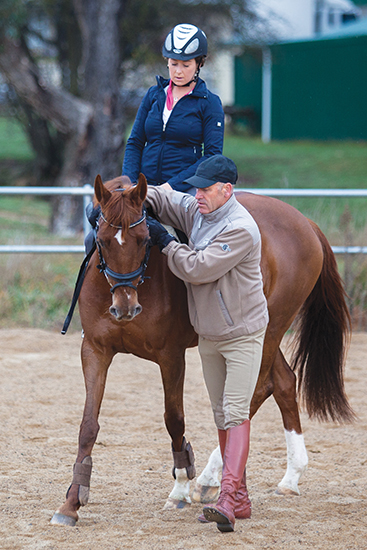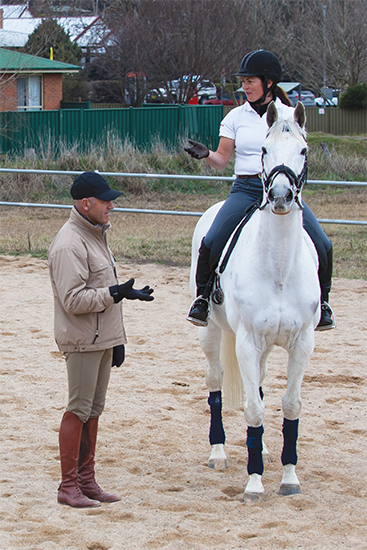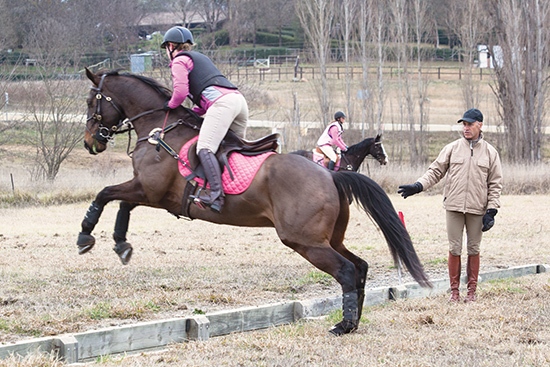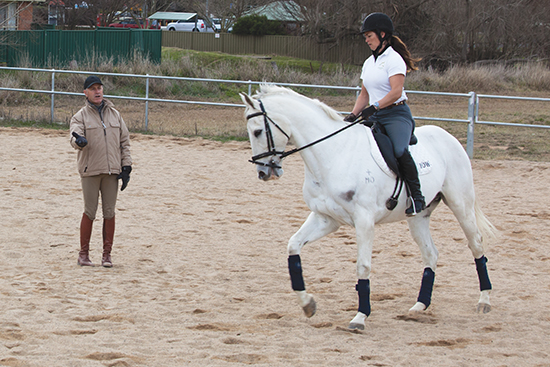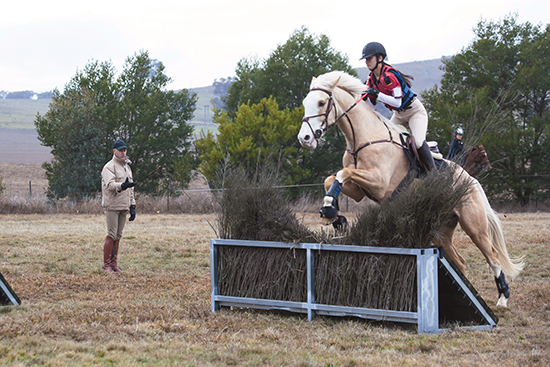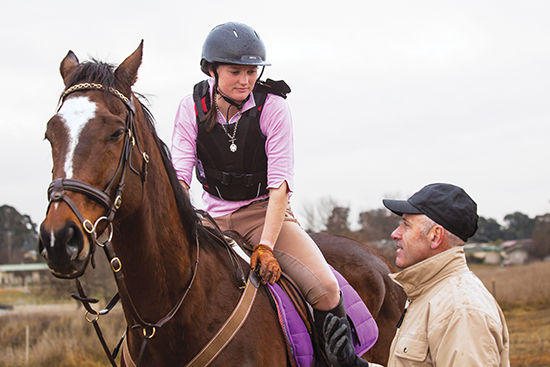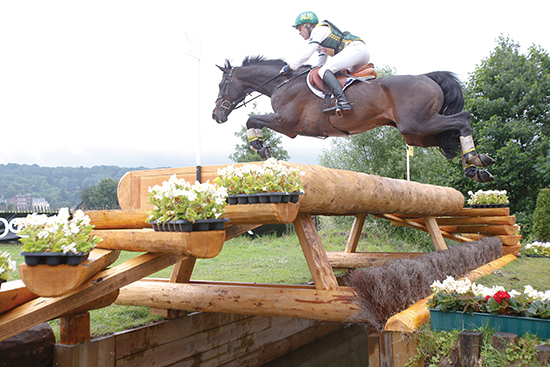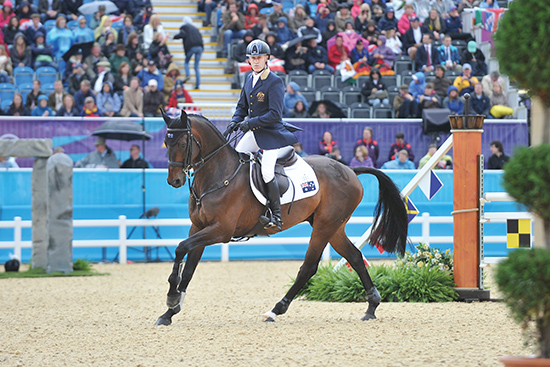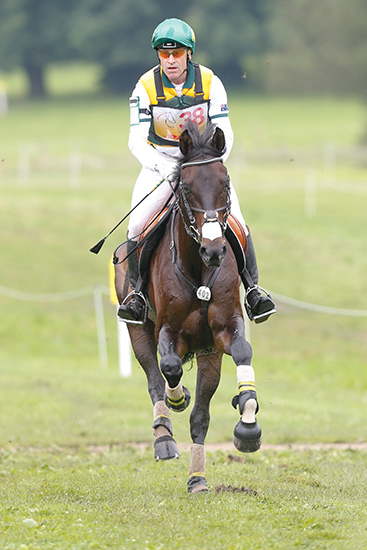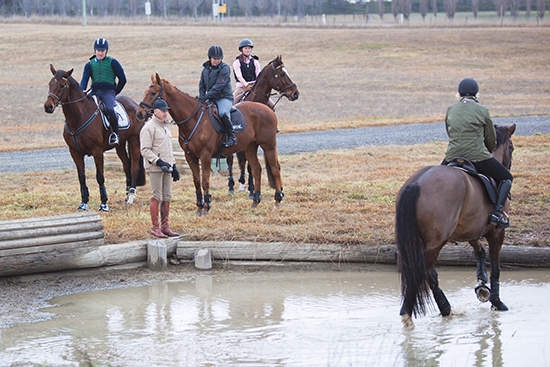 Story & Photos by Rebecca Ashton
Story & Photos by Rebecca Ashton
Forget Tony Robbins if you want a bit of inspiration. The place to be is an Andrew Hoy clinic. The Australian eventing legend has a lot of advice for your time in the saddle, and for life in general.
Having finished eight days coaching in 34 degrees of heat in Bangkok, Andrew took on the chilly Canberra winter in a clinic organised by Natalie Blundell, before heading over to Perth where he regularly helps young riders. Like any successful equestrian, Andrew focuses on the basics. “The more I ride, the more I work on the basics. There is just no quick fix. The basics ARE the quick fix,” he insists.
Andrew is all about creating a thinking rider. His communication with each rider in the clinic was a highlight. “A lesson for me is not just on the horse. It’s the discussion beforehand and what I’m thinking about on the drive home. Communication is really important.” Before each session, he would ask each rider the main point they got out of their previous lesson and at the end, the main ideas they were taking away with them.
During the lesson, he would ask those waiting their turn what they thought of the horse on course and when the rider had completed the exercise, what they thought of it. To a young participant having trouble with a hot horse he advised, “You have to make this happen. I could get on the horse and I guarantee I could ride it. But that’s not what it’s about. I can’t teach you feel. This is about you learning.” Andrew is a strict but fair coach. He wouldn’t move onto the next rider until the previous one had not only understood what he was saying but had also achieved it.
He wasn’t just interested in the riders thinking about the process. They had to act. That’s where the success is. When Amy Roberts was taking bigger, slower lines to give herself time to sort out the situation, Andrew remarked, “We have to react off what we feel. Don’t over analyse things. Yes you have to hear and process the information but then you need to act on that. You’re still analysing when you should be acting. Fix it straight away.”
Andrew didn’t just focus on the faults. When Sarah Farraway had done a good round and Andrew asked her what she thought, she replied, “Alright.” Andrew disagreed slightly. “No, it was good, not just alright. You need to know that. Don’t be like the dressage judges that just give a five for everything. If it’s good, we say so.”
It was just the week before that Sarah had great success at the Young Rider Dressage Nationals across all the levels and it turns out that she isn’t a bad eventer either. Andrew could see the talent, “If you develop this, you will be good. You’re only 15 and you are the master of your destiny. You just have to set the programme.” But just one bit of advice for the young rider, “Clean the mud off your body protector. It’s a dead giveaway!”
Andrew was all for programmes, stating, “Just like any successful businessman or CEO, you have to have a programme; a formula. Your single employee is your horse and he has to do it your way. You have walked the course, the horse hasn’t. You can’t get your confidence from the horse, he has to get his confidence from you. You are the leader.” A good structure will give the horse that confidence. The riders had to find the right formula for each animal.
“Why do some riders always have good horses? Horses are made, not bought. You have to work with the horse. My horses always work with me and give me 110% over a big track. Why? Because I am so consistent with my training and follow a very structured routine; with my riding, in the stable routine, in the truck. When I go to an event, there are no surprises. I don’t have competition tack and working tack. I use the same gear all the time,” Andrew explained.
Nat Blundell was a great example and Andrew pointed this out while she was on the course. “Nat is successful because she has a clear structure. You must know what you want to do and not just hope the horse will save you. Of course sometimes you do something wrong but you only have 10% room for error.”
The seven times Olympian didn’t mind mistakes as long as riders learnt from them. He was quick to point out that the biggest mistake is to do nothing. “There is no one in the world who has been successful by doing nothing. You’re better to do something and get it wrong than to do nothing. I’ve had huge failures but I’ve taken onboard information from people I respect and then acted on it. You don’t live long enough to learn from your own mistakes alone. You have to look at others. To be good, it’s more than just a riding lesson.”
And that’s the thing about Andrew. His advice can be used in life in general.
One strong message of the day was that the rider remain focused on the subject. The subject is either the horse or the jump. “You get zero information from the trees! Do you ever get nervous?” he asked a rider. When the reply was no, “Well I would. I never have a nice feeling if I don’t look at the jump. You have to concentrate.”
He meant concentrate the whole time and never give up when something isn’t quite right. To young Amy Roberts, “You give up on your steering. You ride to the jump and think, ‘Oh damn. I missed it.’ You can neve r give up. You have to fight for it; right to the fence.”
“Look at William Fox-Pitt and Andrew Nicholson. They never take their eye off where they are going. The horse can be weaving all over the place under them but they stay focused forward and just ride it.”
This carried through to hand/ eye correlation. Andrew wanted the hand and the eye to be quite close to allow for better body control. “Look at other sports, downhill skiing, formula1, motogp and jockeys, for example. There is always a correlation between hand, eye and subject. If you sit back you change your eye’s depth of field. Stay up out of the saddle and balance your horse,” he instructed.
He demonstrated the importance of staying out of the saddle on the cross country course so the horse doesn’t flatten and run. When Molly Peters was trying to control her very hot mare, “The body is so influential. You have to stay forward and in balance.” When Molly was at a halt, Andrew told her to stand up out of the saddle and resume a riding position. “Good. Now don’t touch the saddle again until I tell you! Off you go.” The mare was smoother, could stay in rhythm and was happy to accommodate her rider.
Bad riding was quickly addressed as Andrew considers it dangerous. One horse banged her pastern on the edge of a ditch. Although the mare was ok, it made all the riders think when their coach commented, “When I see horses get injured, it really upsets me. It’s cruel. You have to ride your distances well.”
Another stern warning came when one rider took the first half of the course too fast. “I see people die from riding horses and invariably it’s rider error unfortunately. Speed with control is good. Speed without control is dangerous. If you really want to upset me, ride fast without thinking.”
And it was the same with riding too slowly. Most of the slow riding was coming from a place of fear. One young rider kept pulling the horse back because of nerves and fear he would buck her off at speed. She created too much physical effort for the horse to get over the jump. “You’re not worried about the speed. You’re worried about what might happen. You’re thinking of a past experience, not the process here. You have to break through that. Try and let the fear go. Think about what you’re doing not what might happen. I know all about fear and it makes riding painful because it’s always there and you stop breathing. I had very, very good people help me through it, but I had to break through it myself.”
She tried again and the result was very different. She got cranky with herself and more committed and positive. Andrew explained to the rest of us, “This is different. What have I done? I’ve changed the thought process, nothing else. Good riding comes from the thought process.”
The power of the mind was also evident when Rebecca Weal’s horse refused the water and Andrew asked her, “Why don’t you wear spurs cross country?” Rebecca said that her horse didn’t like them. “Tell me a horse who likes spurs! He has to accept them like he accepts the saddle. Just because you wear them doesn’t mean you have to use them.” Although they would come in handy when the horse refused a jump, Rebecca was worried that he would bolt with her. When Andrew enquired as to the last time he had run off, Rebecca had to admit, “Never”. Andrew had a quiet giggle. “I want to come back as your horse in my next life. If I don’t want to do something, I don’t have to! How’s he going to trust you if you don’t trust him? This is a mind thing, not an execution thing.”
Whether on the cross country course or in the dressage arena, Andrew was very strict with riding the rhythm. “If you change the rhythm, you have no rhythm”, he would yell out. A big message for most riders was also connecting the horse up and having him forward in front of the leg but waiting for the fence in balance. When a rider was squeezing too much, “You’re like a crazy woman sending a crazy man mad!” laughed Andrew. Connection also meant verbal cues with the physical action.
Brianna Peet had it sorted. With a lovely position, good elastic elbow and quiet hands, Andrew explained why her cross country course worked, “You held him and kept him together. With his head up a little bit, it changes his balance enough and his presentation to the fence. You’re my model student!”
Molly Peters had the same instruction during her early morning dressage lesson. Molly had to ride with no stirrups while her busy little mare was using every distraction outside of the arena to get out of work. Andrew talked her through it, “She tries to push you away. Keep your lower leg on her and bend her so you get her attention. It has to be forward, not sideways. She has to accept this.” And after steady, patient persistence, she did.
The clinic finished with Natalie Blundell and her sweet little 4 star mount, Algebra in the dressage arena. It was a little rickety to start but Andrew guided, “Swing with the body of the horse rather than drive him. Keep him up in front. The seat rides him forward to keep the shoulder up. Right. Now you look like a partnership.” After some figures of eight, bending work and shoulder in to renvers up the long side, Nat had the half passes flowing beautifully, almost to her surprise. “Wow! Where did that come from?” she enthused. Andrew explained further, “It’s all about finding the rhythm for him. That’s his rhythm. Can you hear his breathing? With that, now your test could be 40-46 and if you can finish on that score, that’s when you start to become competitive.”
Andrew’s final words to his charges was this, “Do I have to teach you how to ride? No. You present yourself in front of me and I can tell you how to get to the next stage. But it is only you who can take you to the next step. We are all responsible for our actions. Put good people around you and pay attention to them. A great support team is essential. I see habits and people say they want to change but only you can do it. It’s your responsibility, not your coach’s or anyone else’s. This isn’t about riding, this is about life”
What is the main point you’d like riders to take away from this clinic?
There is not one point because number one, when they first get on a horse, they need to have correct posture. Number two, they need to have the horse going forward and number three, they need to ride the rhythm. Also there are only the four things that you teach the horse: go forward, stop, turn left and turn right and if one of those is not working then it is a very bad formula.
I doesn’t matter what level I work at and what level rider a work with, I really enjoy working with riders. But it is the rider’s responsibility to take on the improvement. It’s not my responsibility. All I can do is give them the information. They have to find the way; the feeling and I can’t teach them the feeling.
Do you believe in working on rider fitness?
Yes. Rider fitness is paramount. Now that does not mean that the rider has to go and run a marathon to be fit for running, they need to be fit to ride. They need good core stability. Core stability is the one thing that has been overlooked for a number of years and that’s one area that needs focus. You see, the riders can be very fit, but if they do not strengthen the right muscles, then it’s going to be wrong. First of all they need to get on the horse then they need to have correct posture. Correct posture is going to develop the correct muscles.
The older one gets, the more one needs to work on personal fitness. The younger person is very flexible and elastic through all of their muscles and they have a fitness that is automatically there whereas when we get older, we spend more time sitting in front of a computer, more time doing work that’s not related to being outside whereas when you’re young you’re outside playing so it’s much easier.
What do you do for your own fitness?
I go running and I work with a swiss ball quite a lot, exercise that focuses on core stability. I work with a guy who trains me and also keeps me aligned with chiropractic work once a week.
Do you take training ideas from other sports?
Look I’m all the time looking at other sports to see what is relevant to our sport. The one thing that’s very common is the eye/ hand/ subject co-ordination. The closer the hand is to the eye, the more balanced the whole combination is.
What’s your daily routine?
Well a daily routine can be competition because there are just so many competitions in Europe so it’s just a matter of working with the horses and when I’m training horses at home, I’m very structured in the way I go about things.
I’m just working with three horses at the moment and they’re all at different levels. This is where I now need to work more on my personal fitness because I’m not riding as many horses.
What keeps driving you?
It’s the joy of riding; the joy of working with horses. For me, there is one word I can use to describe what I work towards and that’s harmony. The harmony between the horse and rider in all three phases, dressage, cross country and show jumping. Harmony is the word that describes what I look for the most with my own riding. It means that you have a wonderful relationship with the horse and that you understand the horse. Now that doesn’t mean that you treat the horse as a pet, it means that you really respect the animal for the animal’s ability and I always make sure that I work with the horse’s personality.
Tell us about your horses and future plans?
There’s the World Equestrian Games next year and there is Rio as well, now that I’ve got some very nice horses and at the end you only need one horse to win a gold medal. Composer won’t be ready for WEG. Cheeky Calimbo, I ran in Aachen and albeit that I had some problems on the cross country, I was very pleased with the horse’s performance. I believe I can work out those problems. But the horse hasn’t run at a CCI 3* so he needs to do that and WEG is only just over 12 months away. So there would have to be huge results for Cheeky Calimbo. Is he a good horse? Yes, but he’s a horse that I have to work with his personality to make it happen. It’s the same with Rutherglen.
Andrew and Cheeky Climb at Aachen in 2013. Photo: Julia Rau
As a team, what do we need to do to win our next gold?
There’s not one thing that is going to win gold for us. It’s a matter of every rider working on the things that they need to work on. And that’s different for everyone. Some riders need to look at stable management, others need to look at a better competition programme and others need to look at a better training programme. Some need to work more on dressage, some on cross country skills, others more on showjumping, so it’s right across the board. Before coming out here, I met with Prue Barrett and Chris Webb and I think it is very good with Chris coming into the role of high performance manager. He’s very clear in saying that everyone is different and everyone has got different needs and so we need to work with those individual requirements. We need the four best individual performances to make the team perform.
Andrew with Rutherglen at the Olympics
Who have been your most influential coaches?
Probably the one who has been the most influential because I spent the most time with him has been Mark Phillips. But I’ve worked with really good coaches like going back, in the early days Franz Maringer. I was lucky enough to have some coaching with him and he was classically correct; a very, very good man. Tina Wommelsdorf, Bill Steinkraus, the American. These are all names the younger people would have never have heard of. Then there is George Morris. I have enormous respect for George because he is just such a great technician. I was just fascinated with his clinics. When Wayne Roycroft was coach of the Australian team, I always had enormous respect for him in walking the courses and just his way – because I had known Wayne for a long time and knew his style and his way of riding and we had a very good relationship in that area. There’s people now like Laura Tomlinson (Bechtolsheimer). Laura’s 27 years of age and I go to her for dressage lessons because her dressage coach is Klaus Balkenhol who I’ve worked with for a long time. Laura wasn’t in Aachen with me this time but Klaus was and he helped me just before my test and the day before and I ended up doing a 32.8 test with Cheeky Calimbo. That was a great result. Klaus is just a wonderful man. Very soft but very clear with what he wants. Laura’s very good. We have a similar personality so that works well. I think you need a similar personality to your coach so that you can find a good way. For me coaching isn’t just about giving instruction and talking at people, it’s about working out people’s personalities and working with it.
Do you think you’ll ever slow down…Like when you’re 80?
Well…that’s not that far away!!! haha.. It’s interesting….my parents have always been very active and very busy with what they’re doing. They’re still farming here in Australia. I think it’s just in my nature that I always want to be busy. I’m just always fascinated to be always working at the pointy end no matter what I’m doing and I’m one for attention to detail and when you have attention to detail, that’s not something where you just relax and take time out. However I know it’s counter productive not to take a break and this is something that I need to become better at!
This article first appeared in the October 2013 issue of THM.

